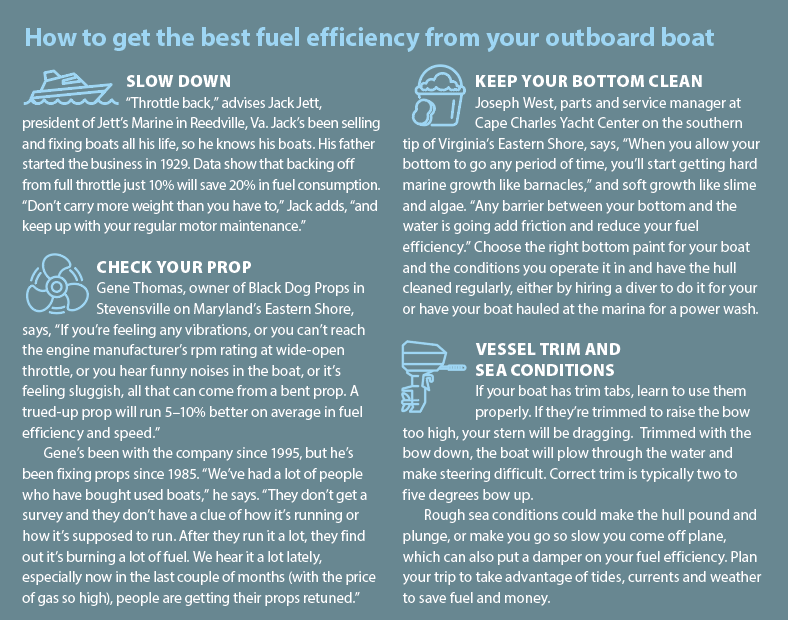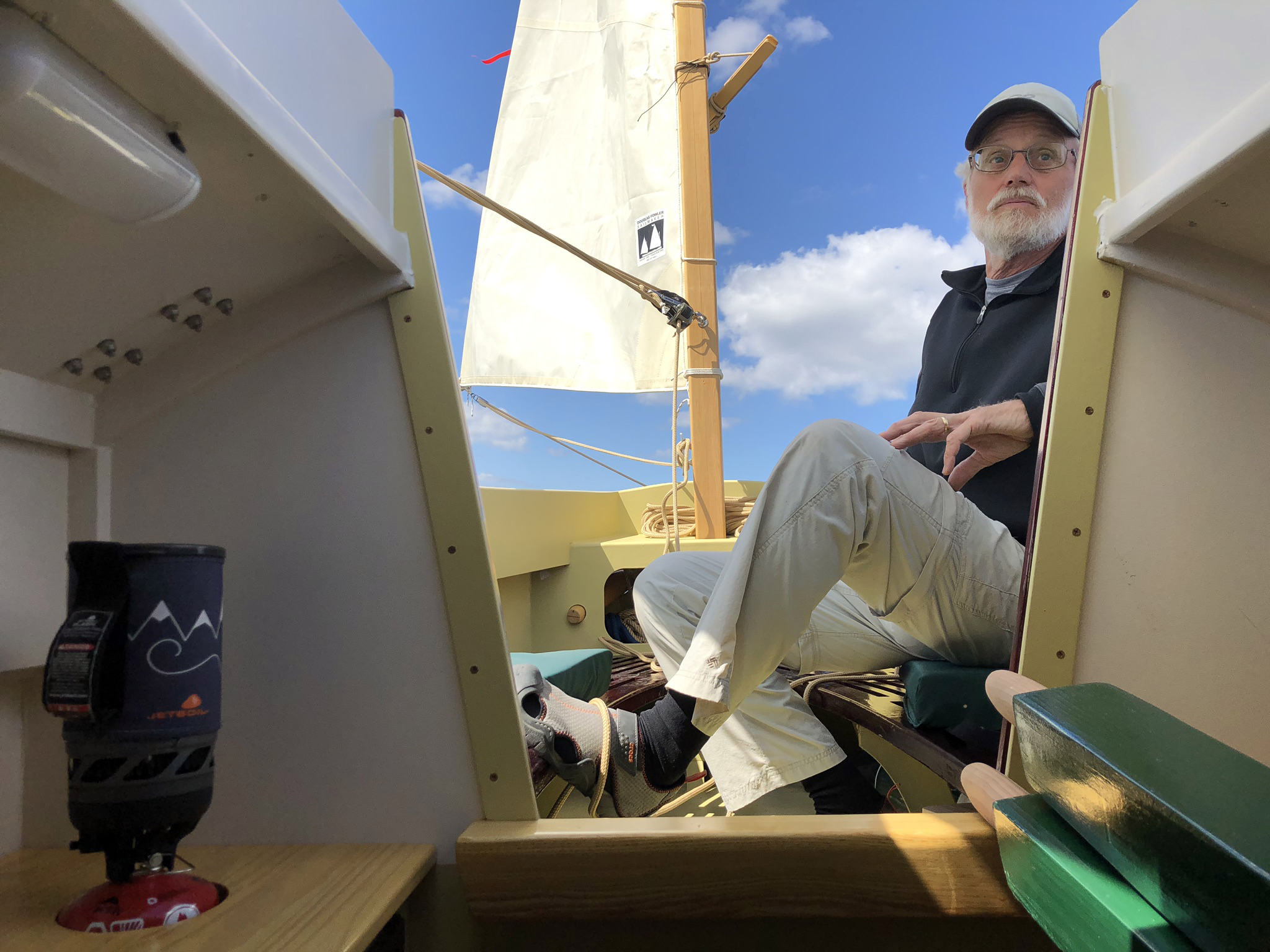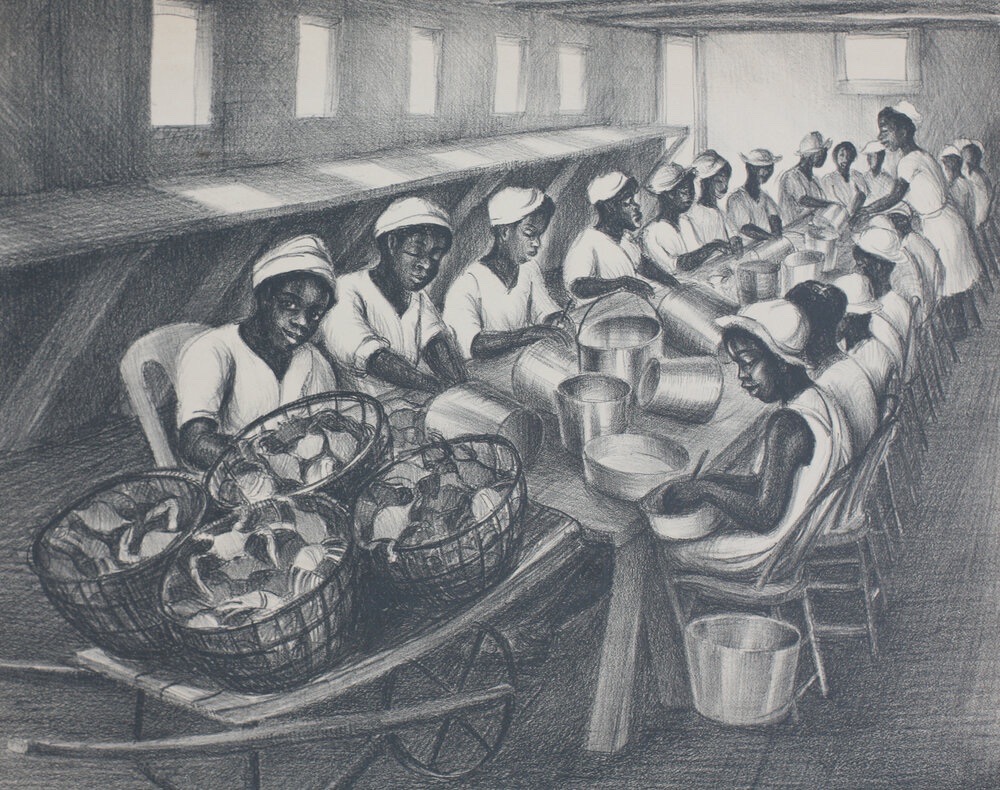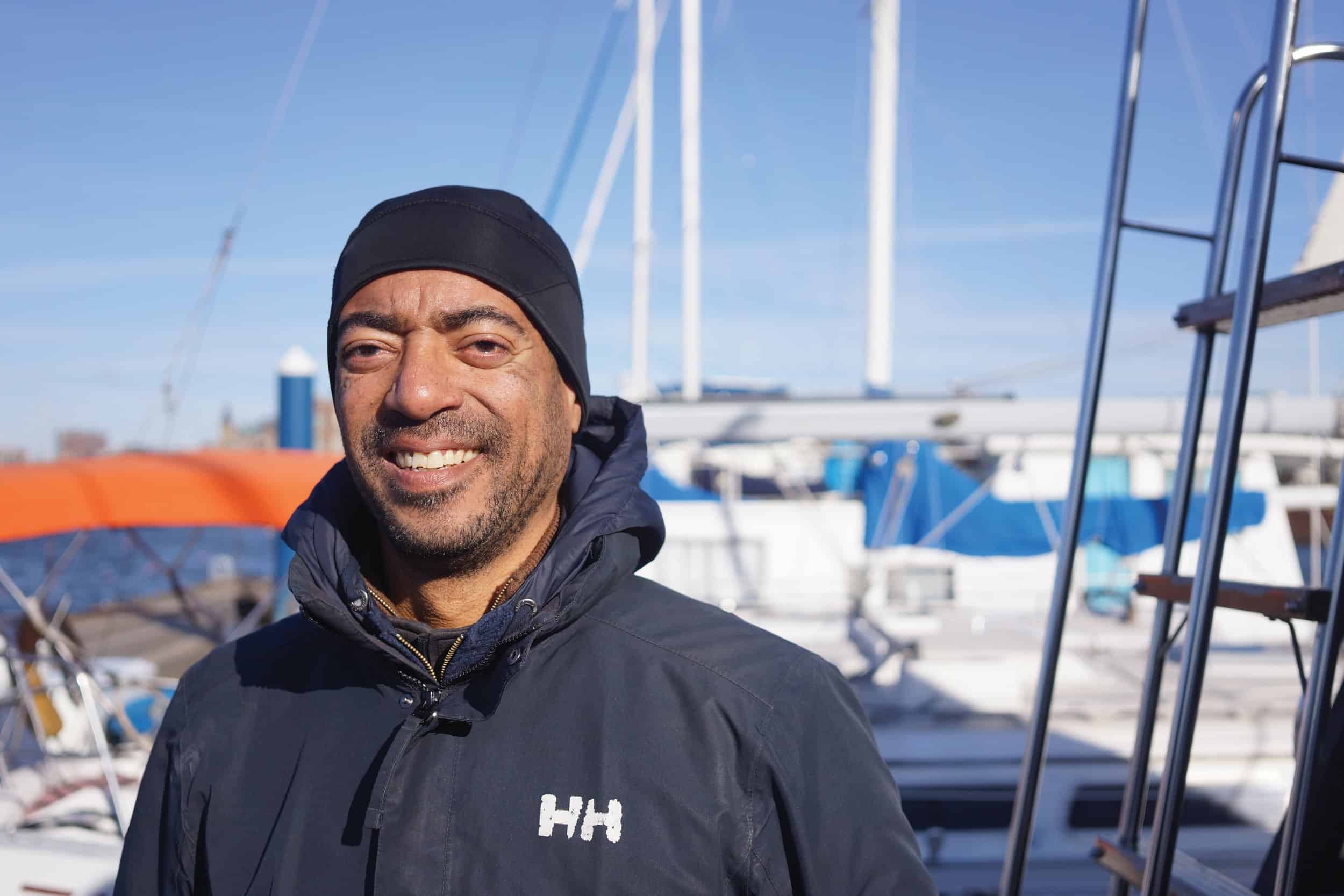Discovering the joys of cruising the Bay in small boats
I have a large fleet of small boats—canoes, kayaks, even an inflatable catamaran rowboat. And I’m not alone. According to the National Marine Manufacturer’s Association, 95% of boats on the water in the U.S. are less than 26 feet—boats that can be trailered by a vehicle to local waterways. The Chesapeake Bay is about 200 miles long from the mouth of the Susquehanna at Havre de Grace to where it opens up onto the Atlantic Ocean between Cape Henry and Cape Charles, but there are more than 11,000 miles of shoreline in between, most of which is inaccessible to boats with keels more than four feet deep. You don’t need a big boat with liveaboard accommodations to explore the Bay, and for most of the nicest spots, a big boat is an actual impediment. Here are three boaters’ experiences cruising the Bay in their small boats.
The Avid Daytripper
Martin Needle keeps his 23-foot Parker center-console in a boatel at South River Marina on Selby Bay, south of Annapolis. It’s less than an hour’s drive from his home in Potomac, outside of Washington, D.C. “In the summer when we have longer days, it’s possible to leave work and get in a couple of hours of fishing or go to a nice waterfront restaurant for dinner. When your boat can go 20–25 mph, that’s easy to do,” he told me over the phone from his office, where he serves as an attorney with the U.S. Dept. of the Treasury.
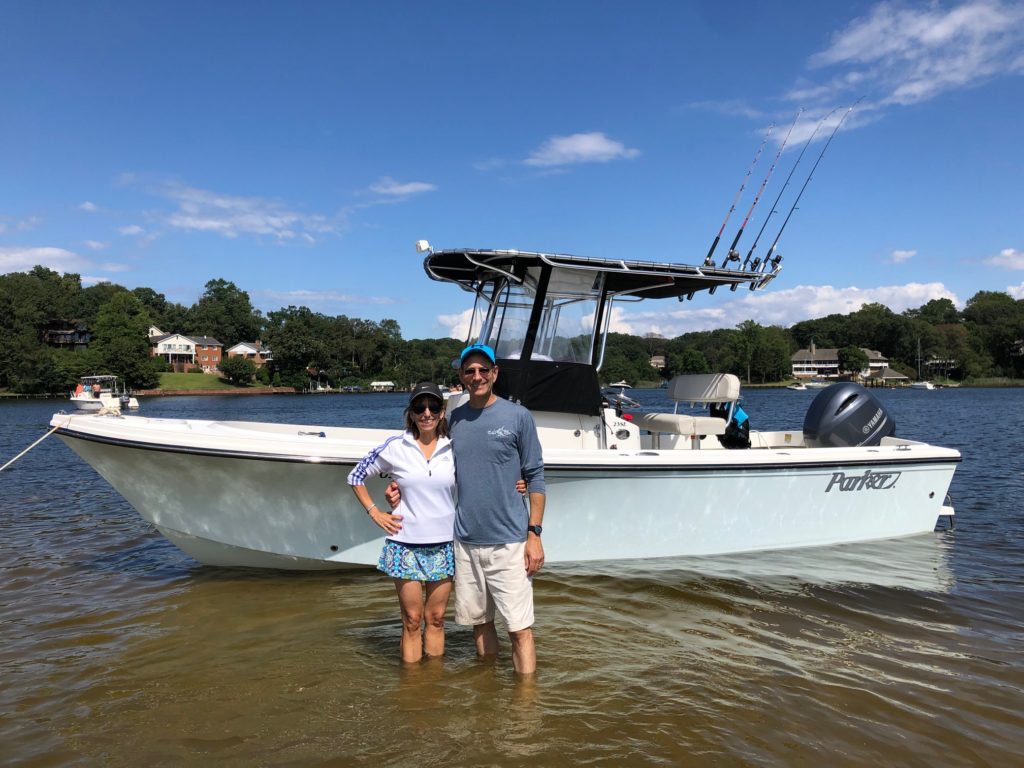
with their 23-foot Parker Center Console

“My wife, Barbara, and I just celebrated our 25th anniversary and boating has always been a strong part of our lives with our two kids,” he added. “My son and I love fishing, and together with my wife and our daughter, we enjoy waterskiing, paddleboarding and cruising. I learned to waterski in Round Bay on the Severn River, and that’s still one of our favorite areas to ski, along with Shaw Bay on the Wye River. Both of my kids learned to ski in those locations.”
I would count Martin and his family among the Bay’s more active boaters. Their season starts in mid-April and runs into November, depending upon the weather. In that time, they routinely clock an average of about 100 hours of running time every year on the boat’s 200 hp Yamaha outboard.
Now 58 years old, Martin was born and raised in the Washington, D.C. suburbs. “I grew up in and around boats my entire life, primarily boating in the Chesapeake Bay area with Annapolis as the home port,” he recalled. “My parents had a cabin cruiser, and we’d spend weekends in Annapolis and cruise to various destinations around the Bay. I served as my dad’s first mate.”
As their kids grew older, social activities and sports began competing with the family’s boating time. “So the concept of going away for the weekends is difficult,” Martin lamented, “but we do a lot of day cruising within a 50-mile radius of our slip on South River. To the north, we can get as far as Baltimore or Rock Hall; to the east, we can reach Kent Narrows, Oxford or St. Michaels; and to the south, we can get to Solomons and back in a day.”
St. Michaels is always at the top of the list, he says. “Anchoring outside the harbor and paddleboarding around the harbor is always fascinating. We love trying new restaurants. We recently discovered the Point Crab House up the Magothy, truly a gem. We enjoy tying up in downtown Annapolis, walking around and going to the ice cream place there.”
Martin opted to buy the Parker center-console in 2016 for its efficiency and simplicity. “With fuel prices today, it’s very economical,” he says. “We rarely spend more than $100 a day. We keep it at a boatel, which takes away all the worry of keeping a boat in the water.”
The Unexpected Adventurer
While the Needle family sticks to day cruising, John Mirassou and his buddies went cruising for 112 days straight. In a 17-foot Boston Whaler Montauk. You could say he wrote the book on small-craft cruising, because he did. It’s called Only in America: Ft. Lauderdale to New York to Chicago to New Orleans in a 17-foot Boat. Mirassou related his adventures over the phone from his home in Redondo Beach, Calif.
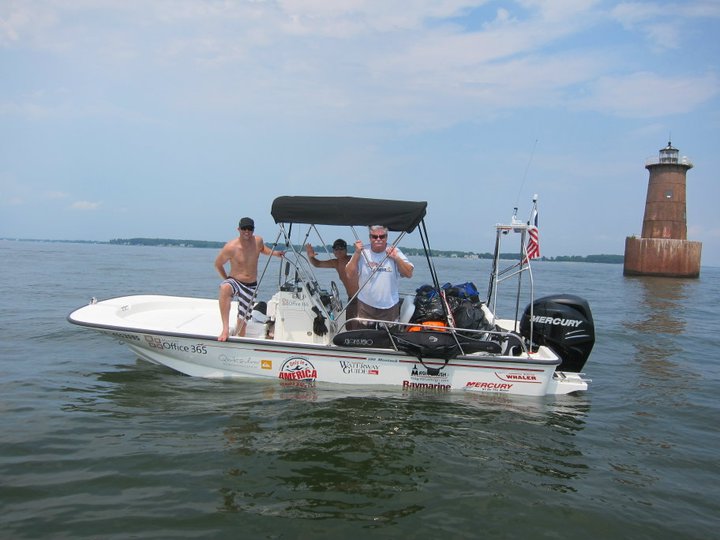
In 1987, at the age of 22, John and his friends celebrated their college graduation with this 5,700-mile odyssey. He published his memoir in 2007, then did another trip from Fort Lauderdale to New York in 2011 as a book tour. On both journeys, they traversed the length of the Chesapeake Bay from Norfolk to the C&D Canal, frequently with one or the other of the crew trailing along on water skis. Many a night, they would simply camp out in the boat. Other times, they relied on the kindness of strangers.
“We’d tie up at a marina and somebody would always ask, ‘What are you doing with all that stuff in your boat?’ and we’d tell them, and they’d always say, ‘In THAT? If you’re crazy enough to do that, I’m crazy enough to buy you a drink!’ And after a few beers in the local bar, they’d offer to put us up for the night. Fifty percent of the time we were put up by people we didn’t even know.”
John often gives lectures on the advantages of cruising long distances in a small boat. “It’s only one engine, so it’s not gas guzzling, and you rarely have trouble finding dock space for the night, especially in the spring and fall when boats are going north and south. You radio in to the marina and ask for a slip and they tell you they’re all full up. ‘But I’m a 17-foot Boston Whaler.’ ‘Oh, we have space for you.’ You never have to stop for a drawbridge, and when you run aground, you get out and push yourself off.”
What happens when it rains? “You find a bridge to hide under, or you look out for the storms and you can quickly get out of the way. Or you just get wet. Sometimes we’d strip down to our bathing suits and dry off afterward.”
They’d average between 100 and 150 miles a day. “The Chesapeake is one place where you could spend two or three months [exploring], but we were on a schedule.” Mirassou was particularly taken by the Potomac River. Here’s an excerpt from the book:
The early morning sun was brilliant yellow as I turned the wheel and rounded Smith Point onto the Potomac River. Although it was a perfect mid-June morning, it was still quite cool, which may have accounted for the conspicuous lack of boat traffic.
“Only 160 more miles and we’ll be in our nation’s capital,” I proclaimed as I took a compass heading and began our long trek up the Potomac River. Although I’d dreamt about it for years, I was still taken aback by the thrill of being atop this historic tributary, navigating our way toward Washington, D.C. As the goosebumps spread, I broke into song and my friends joined in for a rousing rendition of “The Star-Spangled Banner.”
If you’d like to purchase a copy of John Mirassou’s book, Only in America, send an email request to mirassouhere@gmail.com.

The DIY Sailor
I met our third candidate, David Dawson, at the “Big Little Boat Festival,” held Memorial Day weekend at Camp Wabanna at the mouth of the Rhode River near Annapolis. This is the annual event promoting small boats propelled by paddle, oar and sail that’s sponsored by Chesapeake Light Craft. Based in Annapolis, CLC is the worldwide leader in build-your-own boat kits. Their original boat designs include kayaks, canoes, rowboats, sailboats, stand-up paddleboards and even teardrop campers.
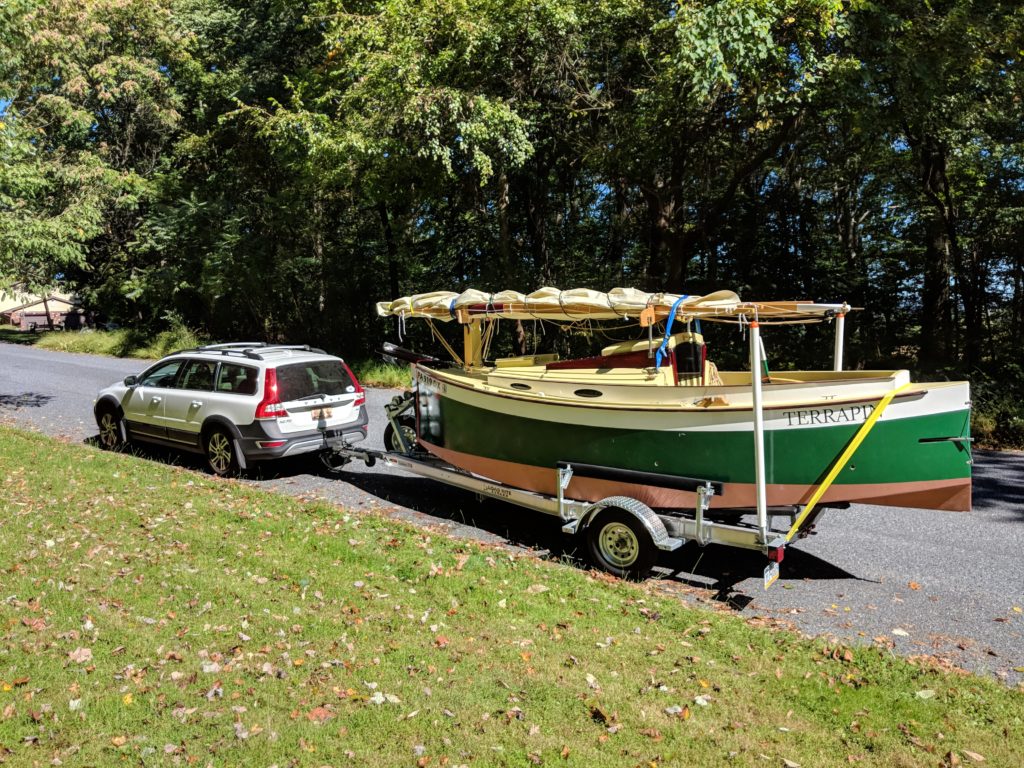
David won the “Best in Show” award for Terrapin, the 18-foot canoe yawl he built in his garage from a CLC kit. Inspired by the boats made popular in England in the 1880s for exploring that island’s rocky coasts, canoe yawls are double-ended craft (read: “pointy at both ends”) with snug but comfortable accommodations for overnighting, and they can be propelled by sail or oar.
The boat was designed by John C. Harris, principal owner of CLC. Harris, who has been a lifelong admirer of the canoe yawl, calls his design “Autumn Leaves.” “To me, a ‘canoe yawl’ isn’t just a design type,” he wrote when describing the craft on the CLC website, “it’s a self-contained, small-boat cruising philosophy. According to this philosophy, skilled boatmen [and women] move their little boats along the coastline in all weather, artfully playing wind and tide to make passages without resorting to engines.”
I interviewed David Dawson by phone while he was aboard Terrapin. He had anchored in Fox Cove in the lee of Big Island on the Rhode River. “I’ve been boating since I was a kid,” he told me. “My dad built some small boats. When I retired, I started downsizing.” David retired 10 years ago from a 37-year career at the Morning Call in Allentown, Pa. He started there as a reporter and moved up into management. “My last boat was a 27-foot trimaran,” he told me, but he wanted a boat he could keep at his home in Cherryville, Pa.—one he could “keep in the garage and one I could trailer anywhere I wanted to go. I wanted it to be the smallest boat with a cabin, and one that didn’t have a motor.”
He chose the canoe yawl because it was designed specifically as a totally human-powered, single-handed cruiser. “It has a lot of ballast, so it’s very stable,” David said, “but it’s got a flat bottom so you can go into very shallow water. And I also I liked the look of it—there’s some old-fashioned charm to it.”
He drove down to Annapolis, rented a U-Haul trailer and picked up the kit comprised of two big boxes on a palate, he recalled. That was in 2018. David built the boat in his garage—“really a boat shed,” he explained, “where I keep all my kayaks. I’ve got a little skiff and about 10 kayaks.” (Like me, David owns a large fleet of small boats.) After about 1,500 hours of work, he had it finished by the fall of 2019.
The end result is 18 ½ feet long, 5 feet wide, and weighs about 1,700 pounds, including more than 500 pounds of lead ballast. “When you load it with gear, it displaces about a ton,” he said. “I tow it with a Volvo station wagon. On the trailer, it’s just about 2,300 pounds, and it tows pretty easily.” This is the start of Terrapin’s fourth season afloat. “I’ve brought it down to the Chesapeake more than anywhere else,” he explained, although he’s also been to the New Jersey coast and Lake Ontario. His home in central Pennsylvania is most convenient to the north end of the Chesapeake Bay, where Dawson enjoys exploring the Sassafras and Chester Rivers, with anchorages in quiet spots like Still Pond and Fairlee Creek.
He eschews marinas. “I always anchor out,” he said. “You just drop your anchor and there you are. I do it real, real, simple after all the complicated boats I’ve owned.” He has a little camp stove to boil water for freeze-dried dinners and coffee in the morning. “It’s not really cooking at all.”
The boat handles easily, even in 20- 30-knot winds, with its lug-rigged sail and spanker. (read: “little sail in the back”) The lead ballast and the twin bilgeboards keep the boat upright under sail. It draws just 8 inches of water with the boards up.
“Because it’s such a shoal-draft boat, you can get up little creeks, places where it’s really quiet,” he explained. “I’m a bird watcher so it’s a good platform for that early in the morning. You don’t get that when you’re marina hopping. That’s why I come down to the Chesapeake. I’m here behind Big Island on the Rhode River, and there are so many places like this.”
When I started investigating this topic, I was sure I’d come across boaters who cruise from destination to destination in their runabouts, dock at an elegant restaurant for dinner and then stay at some quaint B&B every night. Instead, I discovered a family who keeps their cruising to daylight hours, a guy who’s made an impossible Great Loop cruise in a Montauk Whaler, and a birdwatcher who cruises with no motor at all, just wind and muscle.
